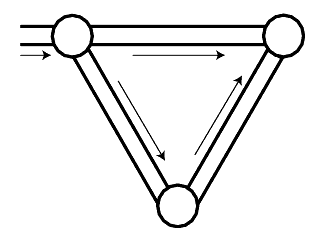Conservation of Mass and Energy
Conservation of Mass
At any node in a system containing incompressible fluid, the total volumetric (or mass flows in) must equal the flows out, less the change in storage. Separating these into flows from connecting pipes, demands, and storage, you obtain:
Conservation of Energy
The conservation of energy principle states that the headlosses through the system must balance at each point. For pressure networks, this means that the total headloss between any two nodes in the system must be the same regardless of what path is taken between the two points. The headloss must be sign consistent with the assumed flow direction (i.e., gain head when proceeding opposite the flow direction and lose head when proceeding in the flow direction).
Conservation of Energy
The same basic principle can be applied to any path between two points. As shown in the figure above, te combined headloss around a loop must equal zero in order to achieve the same hydraulic grade as at the beginning.


